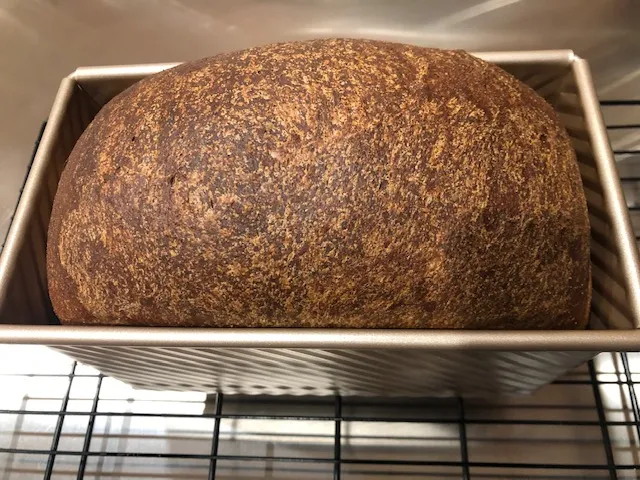
After reading and enjoying Gavin's (gavinc) bakes (here) of Debra Wink's whole wheat loaf bread. It looked so good, I decided I had to try and bake it.
I tried to follow all of Gavin's posts on this recipe, so here goes:
Below are directions from Gavin's post
Milk, egg and water together are the total hydration |
| |||||||||||||||||||
Weigh the milk and egg and enough water to make up |
| |||||||||||||||||||
to 75% - 375-400 grams (solves the problem of egg size) |
| |||||||||||||||||||
Process keys: |
| |||||||||||||||||||
· Develop gluten before adding oil |
| |||||||||||||||||||
· Give the dough two full rises in bulk instead of just one | ||||||||||||||||||||
· Keep the dough cool to cold for the majority of fermentation (no higher than 23C) |
| |||||||||||||||||||
Mixing | Type of mixer | Mixer |
|
| ||||||||||||||||
All except oil/butter |
| |||||||||||||||||||
Rest | 10-20 mins to hydrate |
| ||||||||||||||||||
mix to good gluten development |
| |||||||||||||||||||
|
|
| Add oil /butter until incorporated |
|
|
| ||||||||||||||
Final Dough | DDT | 23 C |
| |||||||||||||||||
Bulk Fermentation | Refrigerate |
| ||||||||||||||||||
1st rise | length of time | 12 hours to at least double |
| |||||||||||||||||
Remove from fridge | Cool room temp, up to 2 hrs if needed |
| ||||||||||||||||||
Degas and fold |
| |||||||||||||||||||
2nd rise | Rise again | 3 to 5 hours cool room temp. Should rise higher |
| |||||||||||||||||
Shaping | Oblong | Divide | 500g doughs |
| ||||||||||||||||
Pre-shape | round |
| ||||||||||||||||||
Resting time | 20-60 mins as needed |
| ||||||||||||||||||
Shape | blunt cylinders |
| ||||||||||||||||||
|
| Proofing device | oiled loaf pan 21 x 11 x 7cm |
| ||||||||||||||||
Proof & Bake | Final Proof time | Approximately 1.5 to 3 hours hour at 22C |
| |||||||||||||||||
Scoring | nil |
| ||||||||||||||||||
Oven type/temperature | Conventional 190C |
| ||||||||||||||||||
Convection 177C |
| |||||||||||||||||||
Total bake | 25-30 minutes | |||||||||||||||||||
Below: doubled in volume after 12 hour refrigeration first rise and 2 hour at 77F RT

Below: almost tripled in volume after aggressive 4-6 sets of S&F and 3.5 hours second rise at RT
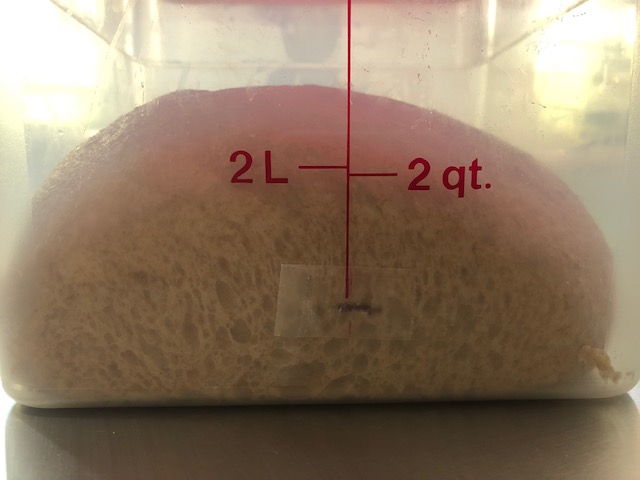
Below: pre-shaped into ball after second rise
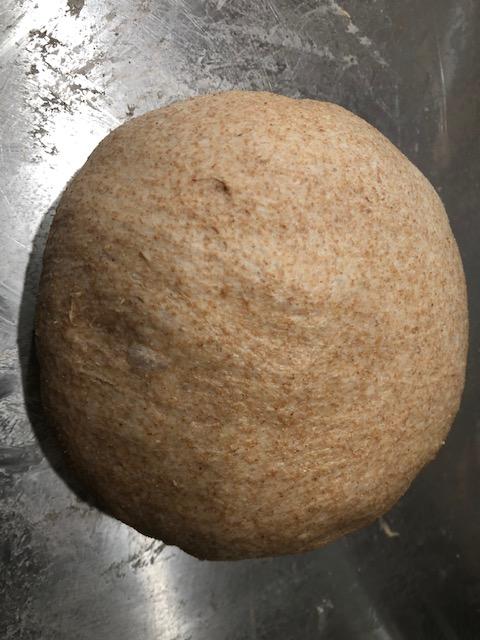
Below: shaped into oblong and placed into 8.5x4.75x4.375 pullman pan for final proofing

Below: final proofing rise - about 2 hours at RT. It rose too high to put the top cover on. Will experiment with dough size so I can get cover on without too much restriction.
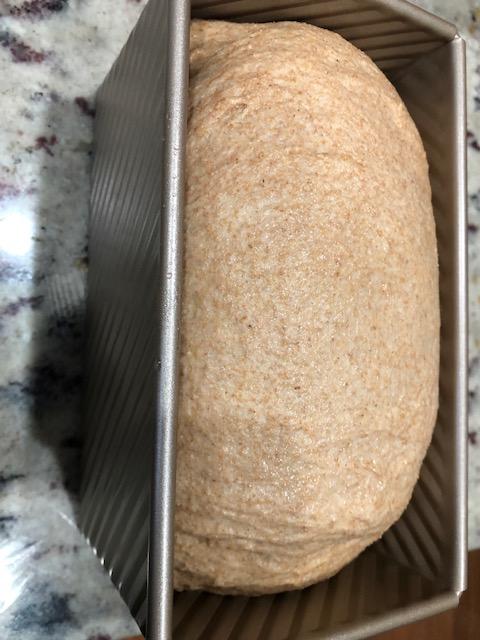
Below: cooling right after baking for 30 mins at 375F

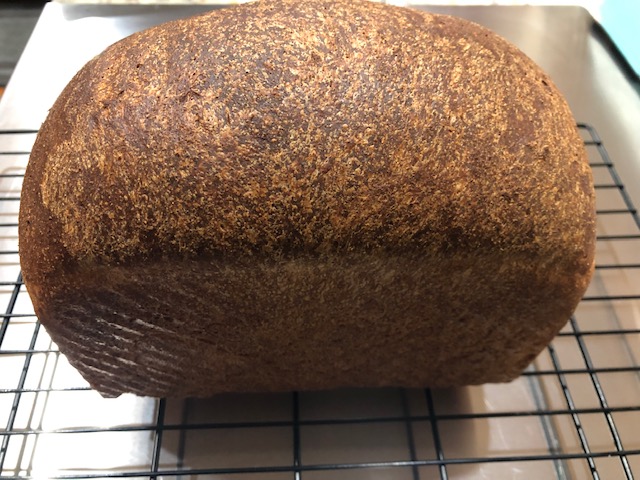
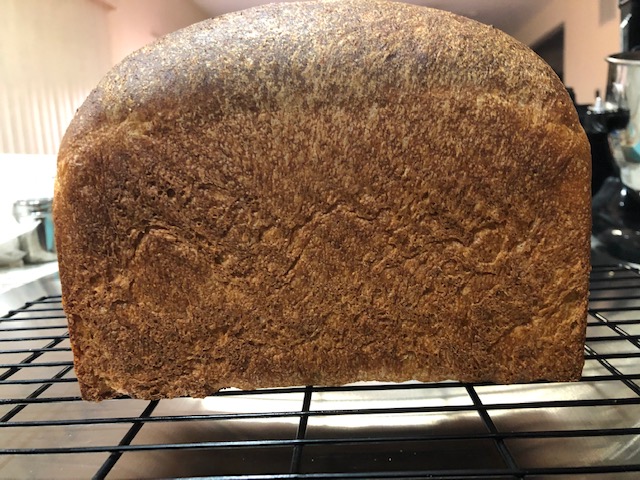
Will get some crumb shots after it finishes cooling down.
Happy baking!
-Paul
Hi Paul. Fabulous! So glad you have tried this. I'm sure Debra Wink will be thrilled also. Also, great write-up of the recipe and process. Exactly true to the original.
Cheers, Gavin
Edit: Nice looking crumb. How would you describe the flavour and texture? Great result especially as it was your first try.
Gavin,
So many thanks to your exploits and Debra's ingenious recipe! My results speak for how your detailed posts were.
I used KA WW flour that Debra had stated was what she originally started this recipe on. I quite like the taste of WW from KA but will probably experiment with adding some of the Spelt flour I have on hand. This sandwich bread loaf tastes exactly what one would expect from a whole wheat bread - wholesome, nutritious, and full fletched flavor. However, I didn't get a ton of sourdough flavor, but I'm quite used to a very pronounced tang in my sourdough breads. Also, with this type of bread, I guess one shouldn't be looking for that Artisan type sourdough tang...
Texturally, I think it's very fluffy - almost Hokkaido milk bread fluffy, but with whole wheat! I will drop the temperature down to 350F as my oven, I guess, is a convection type since it has a fan in the back. That will make it even more fluffy. This loaf is so soft and delicate, 350F should be good.
-Paul
Beautiful crust coloring you got on that loaf, Paul. Deep color brings a lot of good roasty flavor to the loaf. I don't look for a characteristic sourdough flavor as I don't care for tanginess in my whole grain breads, but rather added complexity. Although I personally haven't found the sourdough addition to be worth the extra effort and planning as this is more of an impromptu bread for me. If you like it, by all means continue. I suggested the addition to Gavin as he only has white whole wheat available (and his walnut oil isn't roasted), which can leave this bread a bit bland.
Thank you for reporting your bake :)
dw
Hi Debra,
I thank you for blessing us with your presence, your gracious recipe, and your valuable comments here and in Gavin's threads.
I appreciate your giving this bread a try. Once you're comfortable with the basic dough and process, you'll discover many different ways it can be used --- you can even laminate it with butter to make cinnamon rolls and breakfast pastries. The eggs/yolks or butter can be increased, or the honey, to create something more brioche- or sweet dough-like. Increase the walnut oil for an even softer bread, etc. I started making crackers a couple years ago out of excess dough:
Happy Baking!
dw
Hi Debra. May I ask some off topic questions? If I didn't misread your comment on some post (which I forgot lol), I believe you said yeast is active mostly on the surface of the dough. If the goal is to minimize sourness by increasing yeast activity, would it help by doing certain adjustments:
1. flatten my stiff levain to increase surface area
2. doing stretch and folds very often during bulk ferment to redistribute yeast on surface area?
thank you, I really appreciate it
I believe you said yeast is active mostly on the surface of the dough.
Hi WK, I can see how you could (mis)understand it that way, but what I was trying to say in so many words is that oxygen doesn't penetrate deeply or through the whole dough because it doesn't get past the yeast closest to the surface. It's consumed just about as quickly as it diffuses in --- yeast are greedy that way, but they're plenty active throughout the dough :)
It was in the context of things that can drive acetic acid production by LAB (oxygen being one of them) which works great in pure culture in a test tube with constant stirring. But in real doughs yeast tend to get to it first. I was addressing a myth that because oxygen is a driver of acetic acid production that aeration is needed for that. (But fructose is actually the main driver of acetic acid in lean, unamended doughs.)
Reducing the LAB:Yeast ratio going into your dough is accomplished more effectively through starter maintenance and levain management, so tell me about your starter.
1. The temperature you're keeping it
2. The flour(s) you're feeding it
3. The hydration
4. The feeding ratio (how many grams of starter, water, and flour)
5. How many times per day (plus a photo of what it looks like at feeding time, from both side and top)
Thank you,
dw
Beautiful loaf Paul, you just be so pleased.
Benny
Thanks very much Benny! Most definitely very pleased with how light and fluffy the loaf came out.
Looks to me like you have another winner here, Paul, nice work with the bake using a proven recipe.
Very much appreciate it Ming! Seeing Gavin’s bakes of this recipe and then learning it was originally KA WW without additional wheat gluten made me want to try it out more.
Beautiful! Thanks for your clear writeup. I'm going to try it.
Thank you Gary! Anyone who appreciates a healthy and tasty whole wheat loaf should try this. I just couldn't believe how much rise and fluffiness this bread has. It has been a great experience baking this. I will continue to regularly bake this for our home's sandwich bread.
Way too tall. I should have used 200g of flour as usual instead of the 250 I calculated by scaling.
Very nice texture, simple flavor.
I used 2.5% of my liquid SD starter but don't notice its flavor.
My dough temperature was 83f (28C) using all cold ingredients. I refrigerated for 14 hours to suit my timing. It more than doubled during that time. Second rise was 2.5 hours at 77f (25C). Then final proof was 1.5 hours.
I baked at 350f (175C) convection starting from a cold oven for 45 minutes.
It is 6 inches (> 15cm) tall! 200g of flour would have put it as about 5 inches which is the height I prefer.
Good fun and good eating.
Gary, that's a beautiful loaf! Congrats!
But yeah, you see what I mean by it rising so much more than you would think?
Happy baking!
-Paul
Hi Gary, thank you for adding your comments. Is that a 4 x 4 x 4" mini pullman pan? I don't have one, but I would scale that as 250g of finished dough. 250g of flour should make about two loaves in that size pan. The crumb will be lighter if you give it more room as well :)
My best,
dw
I misread your weights as flour not total. Live and learn.
Oops -- so sorry for the confusion!
Much more reasonable size and softer texture. Very nice.
Thank you Gary for not giving up on this bread after my miscommunication! Looks like you are headed in the right direction. When you're used to lean sourdough hearth loaves it's easy to underestimate the leavening power of this kind dough :)
My best,
dw
I am always looking out for 100% Whole Wheat breads that look like this. I am going to make this one but with fresh-milled whole wheat flour.
Happy baking!
David
Thanks David! I’ve not gotten started on milling my own flour, but that has to be super tasty. Can’t wait to see it!
The total weight of "liquid" ingredients (milk + egg + Water) is 292.5g. This does compute to 75% hydration. Your instruction says they should add up to 375-400g. You didn't adjust your weight from Gavin's version it appears. He made a larger batch of dough than you did.
You also copied Gavin's suggestion for scaling loaves to 500g. Did you use just 500g in your short Pullman pan, or did you bake the entire785g or dough in one loaf?
Thanks in advance for your reply.
David
Edit: not sure what protein level your milled flour will be, but Debra recommends minimum 14% (KA WW level). If lower, she recommended Gavin to add wheat gluten in order for it to rise properly.
I will probably make this is a 13" pullman pan or two 8 X 4" pans.
I believe 13" Pullman Pans usually work with 1 Kg of dough, so I calculated the ingredients to make 1 Kg dough using the formula in Hamelman. Debra's recipe in Hamelman calls for scaling to 500g for 8 X 4" pans. Here's my result:
Ingredients
Wt (g)
Baker’s %
Whole Wheat Flour
510
100
Milk (non-fat)
204
40
Egg
51
10
Water (cold)
127.6
25
Salt
10.2
2
Instant yeast
5.1
1
Honey
61.2
12
Roasted Walnut Oil or Butter
30.6
6
Starter
25.5
5
Total
1000 (w/o starter)
201.3 (196 w/o Starter) *
* Conversion Factor = 5.1 (w/o starter)
Notes
I haven't decided which wheat berries to mill for this. I'm leaning toward Warthog Wheat, and I think that is around 14% protein.
I hope my bread turns out as lovely as yours!
David
David, this dough rises so much that 1kg total dough would probably rise over the top (without lid) - Gavin, at Debra's suggestion in this post, went to 900g for his 13x4x4 Pullman pan and that seems to have been perfect to use with lid for his flour with wheat gluten added.
Since my Pullman pan's volume is slightly less than Gavin's, I had tried it with 785g, but that seems to still be too much for the KA WW flour I used.
I’m sure your fresh-milled bread loaf will taste even better. All I did was follow this great recipe.
David
Hi David,
Here are amounts that work well for me:
13 x 4 x 4" pullman: 800g dough for a loaf the size and shape of a typical grocery store sandwich bread
9 x 4 x 4" pullman: 550g dough
8.5 x 4.5 x 2.5" standard loaf pan: 500g dough
Hamburger buns: 2.25 - 2.5 oz
I've never milled my own grain, so I'll be interested to hear how it goes with that. My current flour is taking up more water, so be prepared to add some (5-10%) if you feel it's needed. The dough should be soft but not loose at the end of mixing, and tacky but not sticky when touched lightly.
Happy Baking :)
dw
You have probably saved me numerous trials (and errors)!
Happy baking!
David
Beautiful bake! I also tried this loaf after seeing Gavin’s posts and really enjoyed it as well!
Looks delicious!
Thank you Troy! It really is delicious, soft, and fluffy.
All these Debra/Gavin bakes made me want to try it again! (3rd time, I think). This time I thought I'd go for the shiny look with the full rye finish of flour paste pre-bake and 2 x potato starch glazes.
I don't bother with the retard on this bake - straight bulk and final proof. It all happens pretty fast.
The big loaf used Benny's Hokkaido style four piece moulding and the smaller tin was shaped "roly poly" aka swiss roll.
Lance
Beautiful Lance, nice to show off several different shapes of the same dough. I love the shiny crust and soft looking crumb.
Benny
Really beautiful loaves Lance! The glaze really brings out such a rich color. It has to be delicious!
Thanks Paul & Benny, I do like the shiny look!
Lance
That crumb looks perfect, Lance. For many years I shined the top of this bread by brushing on an egg white wash pre bake. An egg white whisked with a tablespoon of water. I often had a white or two left over after one thing or another :)
dw
Yes, I guess there are several ways to get a shiny top. An egg white sounds like an easy one and like you, I seem to collect them!
Lance
Skillful baking here, love the appearance. Can you tell me about the flour paste?
Thanks Jon. Do this: make a paste of 1 tbs white flour in 50ml water. Brush your loaf just before it goes in the oven.
Make a corn or potato starch glaze - one tspn starch mixed with a little cold water and pour on 125ml blg water with mixing. It should end up clear and thick; if not cook it a little.
Brush on the loaves at the end of backing. Put back in the oven 5 mins. Take out and brush again. Leave to cool. Very shiny tops!
Lance
Magnificent! Love he finish. My next bake of Debra's will be with red winter wheat I recently sourced with the help of Derek (should arrive in a week or two). I have also obtained some roasted walnut oil. Hopefully these will compete the ingredients to get something like Debra describes. I will not include the sourdough as it was only used to goose the flavour.
Cheers,
Gavin
Good luck with the red wheat. Funnily enough I think I have a preference for white, or perhaps a blend of the two.
Sometimes I find the flavour of the red to be rather strong, but of course in an enriched loaf like this then it's not a problem. And I only have experience of UK grown wheat, which no doubt has a different flavour profile to yours.
You can hardly get hold of white wheat in the UK. There is only one flour sold and no grain whatsoever - it sounds like the reverse of your situation!
Lance